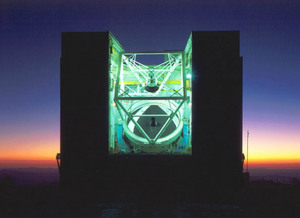
|
| ©MMTO staff member Howard Lester
|
| Sunlight colors the horizon behind the MMT Observatory on Mount Hopkins in Arizona in an undated image. Researchers who developed technology called an astro-comb for enhancing the search for Earthlike worlds plan to test their device at MMT in the summer of 2008.
|
The scientific equivalent of a fine-toothed comb may soon sweep across the skies looking for Earthlike planets outside our solar system.
Dubbed the astro-comb, the technology improves on a highly successful planet-hunting technique called the radial velocity - or wobble - method, which looks for small shifts in the wavelengths of a star's light caused by the gravitational tug of an orbiting planet.
So far astronomers have found more than 270 exoplanets, many using the wobble method, but none of them are Earth-size.
That's because the technology has not been able to measure the very small spectral shifts caused by smaller worlds orbiting in a star's habitable zone.
The performance of the instruments astronomers use to observe starlight often "drifts" due to Earthly factors such as temperature and pressure variations.
Scientists therefore need to continuously recalibrate the instruments by comparing starlight to a standard light.
The astro-comb boosts sensitivity to smaller wobbles via a "comb" of laser lines covering a wide range of the optical spectrum, creating a perfect ruler for calibration.
"This improved sensitivity is required to find lighter planets like Earth analogs, because such lighter planets pull less strongly on stars," said lead study author Chih-Hao Li, a researcher at the Harvard-Smithsonian Center for Astrophysics.
The study appears in this week's issue of the journal
Nature.
Stable and PreciseFor now, the wobble method is limited in part by the stability and precision of spectrographs - instruments that split light from astronomical objects into component wavelengths to show the object's spectrum.
Theoretically, the astro-comb could provide calculations with a hundred times better precision than existing measurements.
"The astro-comb is revolutionary, because it will enable astrophysical spectrographs to be much more sensitive to changes in the radial velocity of stars," Li said.
The astro-comb will also continuously adjust itself to match the atomic clock, making its astrophysical spectrographs extremely stable over long periods.
This is important, Li said, because planets in Earthlike orbits take longer to go around their host stars, so measurements need to be taken over longer time frames.
Li and his colleagues plan to test the astro-comb this summer at the MMT Observatory on Mount Hopkins in Arizona.
They first hope to demonstrate how the astro-comb can calibrate the facility's spectrograph to help measure the effects of dark matter on stellar motion in very old groupings of stars called globular clusters.
Then the researchers plan to use the improved technique to search the sky for small, rocky planets similar to Earth.
No GuaranteeAccording to the authors, the astro-comb could also be used to directly measure the expansion of the early universe.
Such measurements would typically take several decades to complete, because current technology isn't sensitive enough to detect the relatively minor wavelength changes that signal changes in cosmic acceleration.
Astro-combs, in conjunction with next-generation telescopes, could attain those results in less than ten years, the team believes.
"With the astro-comb, for the first time humans could be able to use telescopes to see changes in the large-scale structure of the universe in real-time, over the course of a few years," Li said.
Gordon Walker, a researcher from the University of British Columbia in Canada, wrote a commentary on the study for
Nature but was not involved in the work.
He believes that the astro-comb could be a breakthrough in the precision of astrophysical spectroscopy, but he does foresee some challenges.
"Having the astro-comb is no guarantee that it will be possible to measure the very small wavelength shifts induced by Earthlike planets," Walker said.
"Stars are very 'noisy' targets, having hot gas boiling to their surface and rapid rotation and starspots - all of which may quite confound the search," he explained.
"It will be very interesting to see how well it works at the [MMT] telescope."
Reader Comments
to our Newsletter